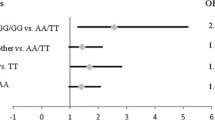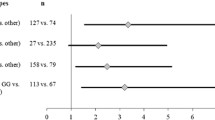Abstract
Objective
DNA repair pathways are crucial to prevent accumulation of DNA damage and maintain genomic stability. Alterations of this pathway have been reported in many cancers. An increase in oxidative DNA damage or decrease in DNA repair capacity with aging or due to germline genetic variation may affect prostate cancer risk.
Methods
Pooled data from two population-based studies (1,457 cases and 1,351 controls) were analyzed to examine associations between 28 single-nucleotide polymorphisms (SNPs) in nine DNA repair genes (APEX1, BRCA2, ERCC2, ERCC4, MGMT, MUTYH, OGG1, XPC, and XRCC1) and prostate cancer risk. We also explored whether associations varied by smoking, by family history or clinical features of prostate cancer.
Results
There were no associations between these SNPs and overall risk of prostate cancer. Risks by genotype also did not vary by smoking or by family history of prostate cancer. Although two SNPs in BRCA2 (rs144848, rs1801406) and two SNPs in ERCC2 (rs1799793, rs13181) showed stronger associations with high Gleason score or advanced-stage tumors when comparing homozygous men carrying the minor versus major allele, results were not statistically significantly different between clinically aggressive and non-aggressive tumors.
Conclusion
Overall, this study found no associations between prostate cancer and the SNPs in DNA repair genes. Given the complexity of this pathway and its crucial role in maintenance of genomic stability, a pathway-based analysis of all 150 genes in DNA repair pathways, as well as exploration of gene–environment interactions may be warranted.
Similar content being viewed by others
References
American Cancer Society (2009) Cancer facts and figures: 2009. American Cancer Society, Atlanta
Lichtenstein P, Holm NV, Verkasalo PK, Iliadou A, Kaprio J, Koskenvuo M et al (2000) Environmental and heritable factors in the causation of cancer—analyses of cohorts of twins from Sweden, Denmark, and Finland. N Engl J Med 343(2):78–85
Bostwick DG, Alexander EE, Singh R, Shan A, Qian J, Santella RM et al (2000) Antioxidant enzyme expression and reactive oxygen species damage in prostatic intraepithelial neoplasia and cancer. Cancer 89(1):123–134
Pathak SK, Sharma RA, Steward WP, Mellon JK, Griffiths TR, Gescher AJ (2005) Oxidative stress and cyclooxygenase activity in prostate carcinogenesis: targets for chemopreventive strategies. Eur J Cancer 41(1):61–70
Khandrika L, Kumar B, Koul S, Maroni P, Koul HK (2009) Oxidative stress in prostate cancer. Cancer Lett 282(2):125–136
Cooke MS, Evans MD, Dizdaroglu M, Lunec J (2003) Oxidative DNA damage: mechanisms, mutation, and disease. Faseb J 17(10):1195–1214
Sikka SC (2003) Role of oxidative stress response elements and antioxidants in prostate cancer pathobiology and chemoprevention—a mechanistic approach. Curr Med Chem 10(24):2679–2692
Rybicki BA, Rundle A, Savera AT, Sankey SS, Tang D (2004) Polycyclic aromatic hydrocarbon-DNA adducts in prostate cancer. Cancer Res 64(24):8854–8859
Rybicki BA, Nock NL, Savera AT, Tang D, Rundle A (2006) Polycyclic aromatic hydrocarbon-DNA adduct formation in prostate carcinogenesis. Cancer Lett 239(2):157–167
Tang D, Liu JJ, Rundle A, Neslund-Dudas C, Savera AT, Bock CH et al (2007) Grilled meat consumption and PhIP-DNA adducts in prostate carcinogenesis. Cancer Epidemiol Biomarkers Prev 16(4):803–808
Christmann M, Tomicic MT, Roos WP, Kaina B (2003) Mechanisms of human DNA repair: an update. Toxicology 193(1–2):3–34
Wood RD, Mitchell M, Sgouros J, Lindahl T (2001) Human DNA repair genes. Science 291(5507):1284–1289
Pierce AJ, Stark JM, Araujo FD, Moynahan ME, Berwick M, Jasin M (2001) Double-strand breaks and tumorigenesis. Trends Cell Biol 11:S52–S59
Jackson SP (2002) Sensing and repairing DNA double-strand breaks. Carcinogenesis 23:687–696
Hu JJ, Mohrenweiser HW, Bell DA, Leadon SA, Miller MS (2002) Symposium overview: genetic polymorphisms in DNA repair and cancer risk. Toxicol Appl Pharmacol 185(1):64–73
Goode EL, Ulrich CM, Potter JD (2002) Polymorphisms in DNA repair genes and associations with cancer risk. Cancer Epidemiol Biomarkers Prev 11(12):1513–1530
Hu JJ, Hall MC, Grossman L, Hedayati M, McCullough DL, Lohman K et al (2004) Deficient nucleotide excision repair capacity enhances human prostate cancer risk. Cancer Res 64(3):1197–1201
Hung RJ, Hall J, Brennan P, Boffetta P (2005) Genetic polymorphisms in the base excision repair pathway and cancer risk: a HuGE review. Am J Epidemiol 162(10):925–942
Xu J, Zheng SL, Turner A, Isaacs SD, Wiley KE, Hawkins GA et al (2002) Associations between hOGG1 sequence variants and prostate cancer susceptibility. Cancer Res 62(8):2253–2257
van Gils CH, Bostick RM, Stern MC, Taylor JA (2002) Differences in base excision repair capacity may modulate the effect of dietary antioxidant intake on prostate cancer risk: an example of polymorphisms in the XRCC1 gene. Cancer Epidemiol Biomarkers Prev 11(11):1279–1284
Rybicki BA, Conti DV, Moreira A, Cicek M, Casey G, Witte JS (2004) DNA repair gene XRCC1 and XPD polymorphisms and risk of prostate cancer. Cancer Epidemiol Biomarkers Prev 13(1):23–29
Ritchey JD, Huang WY, Chokkalingam AP, Gao YT, Deng J, Levine P et al (2005) Genetic variants of DNA repair genes and prostate cancer: a population-based study. Cancer Epidemiol Biomarkers Prev 14(7):1703–1709
Nock NL, Cicek MS, Li L, Liu X, Rybicki BA, Moreira A et al (2006) Polymorphisms in estrogen bioactivation, detoxification and oxidative DNA base excision repair genes and prostate cancer risk. Carcinogenesis 27(9):1842–1848
Chen L, Ambrosone CB, Lee J, Sellers TA, Pow-Sang J, Park JY (2006) Association between polymorphisms in the DNA repair genes XRCC1 and APE1, and the risk of prostate cancer in white and black Americans. J Urol 175(1):108–112 (discussion 12)
Hirata H, Hinoda Y, Tanaka Y, Okayama N, Suehiro Y, Kawamoto K et al (2007) Polymorphisms of DNA repair genes are risk factors for prostate cancer. Eur J Cancer 43(2):231–237
Hooker S, Bonilla C, Akereyeni F, Ahaghotu C, Kittles RA (2008) NAT2 and NER genetic variants and sporadic prostate cancer susceptibility in African Americans. Prostate Cancer Prostatic Dis 11(4):349–356
Stanford JL, Wicklund KG, McKnight B, Daling JR, Brawer MK (1999) Vasectomy and risk of prostate cancer. Cancer Epidemiol Biomarkers Prev 8(10):881–886
Agalliu I, Salinas CA, Hansten PD, Ostrander EA, Stanford JL (2008) Statin use and risk of prostate cancer: results from a population-based epidemiologic study. Am J Epidemiol 168(3):250–260
Sunyaev S, Ramensky V, Koch I, Lathe W 3rd, Kondrashov AS, Bork P (2001) Prediction of deleterious human alleles. Hum Mol Genet 10(6):591–597
Sambrook J, Fritsch EF, Maniatis T (1989) Isolation of high-molecular weight DNA from mammalian cells. In: Nolan C (ed) Molecular cloning: a laboratory manual. Cold Spring Harbor Press, Plainview, pp 9.16–99.9
Ott J (1999) Analysis of human genetic linkage. John Hopkins University Press, Baltimore
Breslow NE, Day NE (1980) Statistical methods in cancer research, volume 1—the analysis of case-control studies. International Agency for Research on Cancer, Lyon
Klienbaum DG, Nizam A, Kupper L, Muller KE (2007) Applied regression analysis and multivariate methods, 4th edn. Duxbury Press, Pacific Grove
Dubin N, Pasternack BS (1986) Risk assessment for case-control subgroups by polychotomous logistic regression. Am J Epidemiol 123(6):1101–1117
The Breast Cancer Linkage C (1999) Cancer risks in BRCA2 mutation carriers. J Natl Cancer Inst 91(15):1310–1316
Johannsson O, Loman N, Moller T, Kristoffersson U, Borg A, Olsson H (1999) Incidence of malignant tumours in relatives of BRCA1 and BRCA2 germline mutation carriers. Eur J Cancer 35(8):1248–1257
Eerola H, Pukkala E, Pyrhonen S, Blomqvist C, Sankila R, Nevanlinna H (2001) Risk of cancer in BRCA1 and BRCA2 mutation-positive and -negative breast cancer families (Finland). Cancer Causes Control 12:739–746
Tulinius H, Olafsdottir GH, Sigvaldason H, Arason A, Barkardottir RB, Egilsson V et al (2002) The effect of a single BRCA2 mutation on cancer in Iceland. J Med Genet 39(7):457–462
Bermejo JL, Hemminki K (2004) Risk of cancer at sites other than the breast in Swedish families eligible for BRCA1 or BRCA2 mutation testing. Ann Oncol 15:1834–1841
van Asperen CJ, Brohet RM, Meijers-Heijboer EJ, Hoogerbrugge N, Verhoef S (2005) Cancer risks in BRCA2 families: estimates for sites other than breast and ovary. J Med Genet 42:711–719
Sigurdsson S, Thorlacius S, Tomasson J, Tryggvadottir L, Benediktsdottir K, Eyfjörd JE et al (1997) BRCA2 mutation in Icelandic prostate cancer patients. J Mol Med 75:758–761
Struewing JP, Hartge P, Wacholder S, Baker SM, Berlin M, McAdams M et al (1997) The risk of cancer associated with specific mutations of BRCA1 and BRCA2 among Ashkenazi Jews. N Engl J Med 336(20):1401–1408
Kirchhoff T, Kauff ND, Mitra N, Nafa K, Huang H, Palmer C et al (2004) BRCA mutations and risk of prostate cancer in Ashkenazi Jews. Clin Cancer Res 10:2918–2921
Agalliu I, Gern R, Leanza S, Burk RD (2009) Associations of high-grade prostate cancer with BRCA1 and BRCA2 founder mutations. Clin Cancer Res 15(3):1112–1120
Edwards SM, Kote-Jarai Z, Meitz J, Hamoudi R, Hope Q, Osin P et al (2003) Two percent of men with early-onset prostate cancer harbor germline mutations in the BRCA2 gene. Am J Hum Genet 72:1–12
Agalliu I, Karlins E, Kwon EM, Iwasaki LM, Diamond A, Ostrander EA et al (2007) Rare germline mutations in the BRCA2 gene are associated with early-onset prostate cancer. Br J Cancer 97(6):826–831
Ostrander EA, Udler MS (2008) The role of the BRCA2 gene in susceptibility to prostate cancer revisited. Cancer Epidemiol Biomarkers Prev 17(8):1843–1848
Braithwaite E, Wu X, Wang Z (1998) Repair of DNA lesions induced by polycyclic aromatic hydrocarbons in human cell-free extracts: involvement of two excision repair mechanisms in vitro. Carcinogenesis 19(7):1239–1246
Platz EA, De Marzo AM, Giovannucci E (2004) Prostate cancer association studies: pitfalls and solutions to cancer misclassification in the PSA era. J Cell Biochem 91(3):553–571
Kondylis FI, Moriarty RP, Bostwick D, Schellhammer PF (2003) Prostate cancer grade assignment: the effect of chronological, interpretive and translation bias. J Urol 170(4 Pt 1):1189–1193
Albertsen PC, Hanley JA, Barrows GH, Penson DF, Kowalczyk PDH (2005) Prostate cancer and the Will Rogers phenomenon. J Natl Cancer Inst 97(17):1248–1252
Acknowledgments
We are grateful to all the men who participated in these studies for their time, effort and cooperation, and interviewers for their help with data collection. This work was supported by NIH grants R01-CA56678, R01-CA092579 and contract N01-CN-05230 from the National Cancer Institute. Additional support was provided by the Fred Hutchinson Cancer Research Center and the Intramural Program of the National Human Genome Research Institute. Ilir Agalliu was supported by funds from the Albert Einstein College of Medicine of Yeshiva University.
Author information
Authors and Affiliations
Corresponding author
Rights and permissions
About this article
Cite this article
Agalliu, I., Kwon, E.M., Salinas, C.A. et al. Genetic variation in DNA repair genes and prostate cancer risk: results from a population-based study. Cancer Causes Control 21, 289–300 (2010). https://doi.org/10.1007/s10552-009-9461-5
Received:
Accepted:
Published:
Issue Date:
DOI: https://doi.org/10.1007/s10552-009-9461-5




